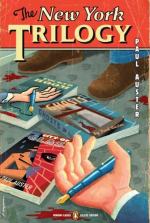|
This section contains 510 words (approx. 2 pages at 400 words per page) |

|
The New York Trilogy Summary & Study Guide Description
The New York Trilogy Summary & Study Guide includes comprehensive information and analysis to help you understand the book. This study guide contains the following sections:
This detailed literature summary also contains Topics for Discussion and a Free Quiz on The New York Trilogy by Paul Auster.
The New York Trilogy by Paul Auster consists of three exciting detective stories: City of Glass, Ghosts, and The Locked Room. Each is a thriller that is brilliantly written and sure to hold the reader's interest. Auster's writing style raises the mystery to a new level, with constant plays on words.
The three books are not independent, as Auster says in the next-to-last chapter of the book. The three books involve writers and detectives and in each case the main characters more or less switch places and take on each others roles, in a manner of speaking. The main character loses himself in a psychological tangle which may be called a breakdown of sorts.
In City of Glass the main character, the writer of detective novels, receives a phone call in the middle of the night which results in him taking on the role of a detective trying to save the life of a man who was the subject of an experiment as a child. The writer, Daniel Quinn, becomes the subject of an experiment at the end with another writer looking for him. He is helpless to walk away from a case that was a set up.
Ghosts is another detective story with a man named White hiring a detective named Blue to watch a writer named Black. Both Black and Blue are driven to the brink of insanity with Black doing nothing but reading and writing and Blue not dealing well with the boredom and inactivity associated with the assignment. Blue is also caught in the trap and unable to walk away from the situation until the very end.
In The Locked Room, the writer becomes trapped in the situation by his childhood friend, Fanshawe. The writer takes on the task of reviewing the works of the missing Fanshawe. He becomes obsessed by the search for Fanshawe and finally realizes the wisdom of his wife's words that Fanshawe has to be dead in order for their marriage to survive. When the writer let Fanshawe with his life, he let the craziness in. He manages to walk away from the craziness after having a breakdown. When he is contacted by Fanshawe, and given a notebook he destroys it, refusing to allow the craziness back into his life.
All of the psychological twists the Auster uses add a new dimension to the mystery novel as the real mystery is what is going on inside the main characters and the struggle that is taking place within them. The author states the City of Glass, Ghosts and The Locked Room are all the same story. Each one represents a different state of awareness since the main character becomes trapped in the situation. The character doesn't escape in the first case, but does in the other two.
Readers of mystery novels will find this book to be very interesting. The novel in relatively easy to read, as the reader follows the struggles of the main characters. It is recommended reading for those who like unusual kinds of mystery novels.
Read more from the Study Guide
|
This section contains 510 words (approx. 2 pages at 400 words per page) |

|



